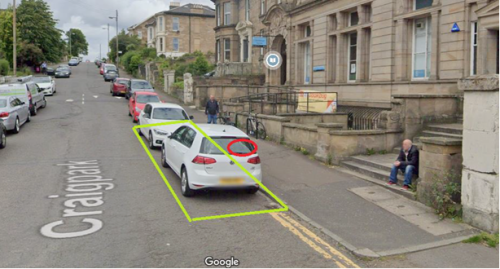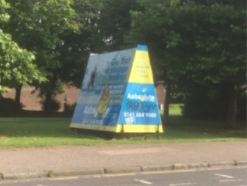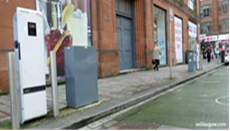A reply from Glasgow City Council to queries submitted by Dennistoun Community Council to the Dennistoun Area Partnership meeting held on 1st September 2021 is below.
It is followed by a response from Dennistoun Community Council.
A PDF version of the GCC reply is available here.
A PDF version of the DCC response is available here.
GCC Reply: Friday 17th September 2021
Thank you for your recent enquiries on behalf of Dennistoun Community Council. I have liaised with colleagues across the service and have detailed below information in relation to each topic. For ease of reference I have provided responses in the order submitted and highlighted the topics/enquires raised by you in blue with responses in black.
As I mentioned at the recent Area Partnership I am happy to attend a DCC meeting. I would ask however that I am given notice of issues DCC would wish to discuss to ensure I have an opportunity to liaise with internal colleagues prior to the meeting.
1. Known Projects
What are the latest timelines for each of these projects?
In what ways are they formally communicating progress and developments – both internally within GCC and, then, how are the outcomes of these considerations directly communicated to external stakeholders such as DCC and others?
- LTN (review)
All measures and infrastructure introduced under the Scottish Government’s Spaces for People (SfP) programme within Glasgow, are subject to a review and reporting process. This review is made up of 3 separate data sources. A public consultation process, physical user counts taken via video survey’s (where appropriate) and finally a review of the strategic policy of the City Council and Scottish Government with regards travel / transport, liveable neighbours etc. The output from this review will be a written report. The report will be submitted to the City Administration Committee, the Committee will decide the future of all SfP measures and whether they are to be made permanent or removed. Online public engagement for these measures was held in May and June 2021 and received nearly 4000 individual responses.
- Liveable Neighbourhoods consultation (proposed)
The Liveable Neighbourhood (LN) programme is in its infancy however we will see an increase of activity in the coming month on the first tranche. Arcadis have now been appointed as the consultant to take forward the project in the Dennistoun to Cranhill LN area. They will officially start work mid-September. We are awaiting the project programme from the consultants to inform us of the timeline however we expect a rapid start. Arcadis will hold a number of on street and in person engagement sessions and workshops with local stakeholders and communities across Dennistoun, Haghill/Carntyne and Riddrie/Cranhill, as well as use the digital engagement platform, similar to that used for the Spaces for People activity. We will of course be taking cognisance of this previous engagement on board.
The project will operate through RIBA stages 0-2 to September 2022. Stage 0-1 will see the consultants gather information for an area study and undertake collaborative local engagement to generate a list of proposed local projects under a series of 4 themes, These can be found on our LN Story Map. Stage 2 will see collaboratively selected local projects taken to concept design. This will allow for a library of local projects that can be presented for funding bids to take the identified projects to technical design and then construction.
It is important to note that Liveable Neighbourhoods does not have designated funding.
Due to the nature of Liveable Neighbourhoods we are working with and informing a number of internal departments such as Planning and Roads. Progress and development will be communicated through Glasgow City Council Webpage and Digital media such as Twitter. This will also be displayed via our digital engagement platform when it is live.
Arcadis / council officers will be in contact directly with local stakeholders to provide more information.
- RPZ (consultation)
Work was due to recommence on this project in September, however due to resource issues this will be delayed. NRS do not have alternative timescales at this time.
- Pavement parking ban (advance preparation)
The Transport (Scotland) Bill, which received Royal Assent on 15 November 2019, will introduce a ban on footway parking across Scotland and would allow local authorities to enforce vehicles parking on footways and adjacent to dropped kerbs, however, Transport Scotland has yet to produce guidance to local authorities on the implementation of the ban including the criteria and process for exemptions. Until such time as the regulations and guidance are published, we are not in a position to comment on how the ban and any exemptions will be implemented. Unfortunately, there is currently no indication on when the regulations and guidance will be in place.
- LEZ (post-consultation)
What are the latest timelines for each of these projects below?
The preferred scheme design for the LEZ has been published as part of the recent consultation exercise. The LEZ will come into effect on 31st May 2022 and this will begin a mandatory grace period, set in legislation, of one year before enforcement begins. Therefore the LEZ will be enforced from 1st June 2023. Vehicles registered to residential addresses within the LEZ will be subject to a further year grace period. Therefore the LEZ will be enforced for these vehicles from 1st June 2024.
Full details of the preferred LEZ scheme design can be found at https://www.glasgow.gov.uk/LEZ
In what ways are they formally communicating progress and developments – both internally within GCC?
Progress on LEZ development is communicated through inter-departmental working within GCC and through external oversite groups such as the LEZ Consistency Group, the LEZ Enforcement Group and the LEZ Leadership Group.
How are the outcomes of these considerations directly communicated to external stakeholders such as DCC and others?
GCC have communicated LEZ developments through our dedicated website, social media, traditional media (including radio advertising), workshops, engagement events and direct communication channels. The two public consultations on the LEZ have utilised all of the above communications methods, including direct mail to LEZ residential addresses.
GCC officers have presented to the Community Council’s Development Session on the LEZ and have communicated developments, such as the recent consultation, through the GCC Community Council Officer, directly to the various Councils.
As the LEZ continues to develop and enforcement approaches, the need to communicate with stakeholders and the public will increase.
Our communications and engagement activities will increase accordingly.
- Inner East SDF (post-consultation)
Timeline – the consultation for the Inner East SDF closed on the 3 September. There were 470 responses and it will take time to go through them and amend the document where required. This process can take a number of months, but we would hopefully be moving towards a final version of the SDF in spring 2022
Communication – the finalised SDF will be presented to GCC Committee for approval and then to the Scottish Government for adoption. We will promote the SDF externally through the existing GCC media team (using press releases and social media etc). Once adopted we aim to report annually to Committee on the delivery of the Action Plan.
- Learning Quarter and Merchant City – City Centre District SDFs (ongoing)
These documents are being considered internally at the moment, it is expected that this process will take another three weeks or so.
After that they will go to Committee for permission to formally consult the public on the documents before they are considered for approval by the Committee. It is still expected that this will take place at the beginning of next year.
This was presented to the Community Council during the development of the DRF’s and DCC will be contacted once the formal consultation period is underway.
- Others?
The process outlined above for the SDFs applies to all the SDFs we are undertaking in our team. To date, SDFs have been adopted for the River Corridor, Govan-Partick and the City Centre. The SDF for Glasgow North is being finalised and the Inner East SDF will follow
2. Cycle lockers
The units were always destined to be installed in a variety of locations depending on the locations.
The referenced committee paper provided these locations.
In some cases (the presence of drain covers or gas valves for example) infrastructure that was not picked up during surveys lead to the locations being altered.
3. EV charging points
EV charging points are to be installed ‘on-street’, as indicated in the image below. Although the chargers themselves are on the pavement, the parking bays will be on the carriageway.
This is to minimise the risk of accidental damage to the EV Chargers. We ensure there is 2m clearance on the pavement for pedestrians and wheelchair users

The chargers are placed on the toe of the pavement (nearest the roadside). The cars use a cable to plug in to the charger so there is a cable but only about 0.5m between the vehicle and the charger, as shown below. This image is from Wilson Street in the Merchant City. The second image is the same location but shows the pavement remains accessible.

With Scotland committed to phasing out petrol and diesel vehicles by 2030, we’re having to deploy units all across the city, both on street and in car parks. Having one in an area is an amenity and helps to facilitate that transition.
4. Pelican crossing on Duke Street at Whitehill Street
Contractors experienced operational difficulties in the full delivery of these works, however lining works on Duke Street are expected to commence on Thursday 16 September 2021.
5. Co-wheels car club
Unfortunately this car was written off and following an insurance claim has had to be re-ordered as a new vehicle.
There are delays on new cars at the moment and Car Club informs me that there are a variety of global reasons due to Covid, which has meant car manufacturers have been struggling to procure microchips, this has created a backlog of orders.
Colleagues have advised that the first available car will be assigned to this location. Please be assured that it is being replaced but we don’t have an exact date yet.
6. Advertising trailers
I have raised this internally with Planning and Enforcement colleagues and when I have a response I will provide this to DCC.


I trust this is of assistance.
Neighbourhood Liaison Co-ordinator (Dennistoun)
Neighbourhoods, Regeneration and Sustainability
Glasgow City Council
DCC Response: Monday 27th September 2021
Thank you for the detailed reply to the DCC enquiries submitted via the Dennistoun Area Partnership meeting of 1st September 2021. DCC comments in response are as follows.
1. Projects
There is much useful and genuinely enlightening detail on current projects to take away from your reply. DCC welcomes this and looks forward to engaging with each of them constructively as progress continues.
2. Cycle lockers
The information provided is useful, but it is generic rather than specific. There doesn’t appear to be any presence of drains or covers that justify the move of the proposed Armadale Street locker onto Garthland Drive (to a location under overhanging trees which are already beginning to have an effect on the locker below). There’s a gully/drain where the Whitehill one was proposed, but that doesn’t explain why it was moved onto the footway rather than to a nearby alternative carriageway location.
What, specifically, are the reasons for the amended siting of each of the cycle lockers in Dennistoun away from their originally proposed carriageway locations?
3. EV charging points
The response provided does not answer our enquiry about EV charging points. “To minimise the risk of accidental damage to the EV Chargers” is a disappointing justification for installing vehicular infrastructure in active travel space when examples of installation in the carriageway exist (e.g. 118 Torrisdale Street and 471 Victoria Road). Further, it does not respect the hierarchy of transport modes.
Putting aside that failure against basic principles, the installations fall short against the claim that “we ensure there is 2m clearance on the pavement for pedestrians and wheelchair users”.
At the EV charger outside the library on Craigpark there is only 1.5m pedestrian clearance for pedestrians between plinth upstand and empty cycle stand (which will be reduced to even less whenever the stand is use). But even if the cycle stand were removed entirely and relocated elsewhere, there still wouldn’t be the physical space available for a 2m clearance between the new charging point installation and the existing wall at the rear of the pavement).
The two EV chargers on Millerston Street at Craigpark Drive each leave 1.75m clearance between the new charging point installation and the existing wall at the rear of the pavement (reduced to 1.5m if accounting for the detritus and vegetation that narrows the practicably useable space).
The 2030 target is worthy in many respects, but it is not an excuse to further lower or override standards for active travel provision in deference to provision of motor vehicle infrastructure as has happened in these initial instances in the area. It sets a very grim precedent for the subsequent tens/hundreds/thousands of EV charger installations installed in Dennistoun, Glasgow and Scotland.
“Having one in an area is an amenity”, yes, but there is no excuse for that amenity being introduced to the clear and unambiguous detriment of pavement users. All on-street EV chargers should be in the carriageway space.
Why are EV chargers being installed within active travel space rather than within the ample carriageway space available, when there are precedents showing that it is entirely possible for this to be achieved?
The stated ‘2m clearance’ was not achievable with an on-pavement installation at either the Craigpark or Millerston Street location, yet EV chargers were still installed on the pavement: why is GCC not meeting its stated standard, and what will be done to correct the problem for this and future instances?
4. Road markings on Duke Street
The Duke Street pelican crossing near Whitehill Street has been back in operation since 16th September after an overdue return visit from the markings team. But it Additionally, there are still various places where the markings on Duke Street still do not match what was there before the resurfacing, including the following:
- At pelican crossing between Sword Street and Thomson Street: No studs along crossing route.
- At top of Thomson Street: hatched corner missing next to loading bay outside Essence of Beauty (No. 350B), and resultant changed junction geometry.
- Outside Florresters (No. 447): Loading bay text missing.
- Outside Techbytes (No. 356): Parking bay separator missing.
- Outside Commonwealth Central Practice (No. 362): Loading bay text missing.
- Outside Coia’s (No. 477): Loading bay text missing.
Furthermore, previous resurfacing work on or near Duke Street has taken place in recent weeks/months/years and is still without follow-up road marking reinstatements, including the following:
- McIntosh Street: markings not reinstalled after resurfacing.
- Duke Street at Craigpark: there used to be a hatched yellow box here before the carriageway was patched up.
- Hillfoot Street: yellow lining inconsistencies (double/single/associated parking plate signage).
Can the above road marking issues be reviewed, and corrected where appropriate (along with any other issues not mentioned but which may also be applicable within the scope of this enquiry)?
5. Co-wheels
Thank you for the new information provided which had not previously been made available by Co-wheels in response to previous enquiries. It is good to know that the return of a Co-wheels car to Whitehill Street is being dealt with as a priority.
6. Advertising trailers
We appreciate that the advertising trailers have been raised internally and look forward to their removal in due course.
7. Spaces for People/Contraflow cycling
As the Designer of the scheme, ultimate responsibility for amendments to the scheme are the responsibility of GCC.
DCC accepts that “the contraflow cycling measures were removed in response to feedback from Police Scotland which highlighted the risk of collision in the narrow residential roads“, and that GCC has evidently taken this input and acted in agreement. But, thus far, no explanation has been given on the basis for the alleged risk, or how that risk is more significant than already exists on adjacent two-way streets.
Can GCC explain how well-marked and properly-signed one-way streets with contraflow cycling create a risk additional to that which exist on numerous otherwise identical two-way streets?
Subscribe! To get DCC updates delivered to your inbox, enter your email address into the box in the menu section of this site and click Subscribe Now! (To the left of the screen in desktop view, or via the menu button at the top of the screen in mobile view). Easy to unsubscribe from at any time.



One thought on “Update on Submission to Dennistoun Area Partnership: September 2021”